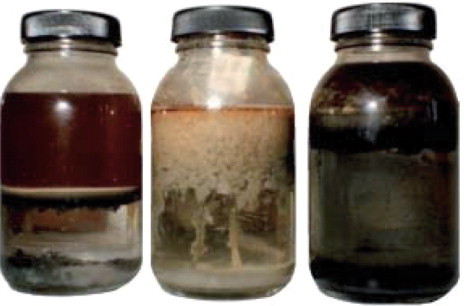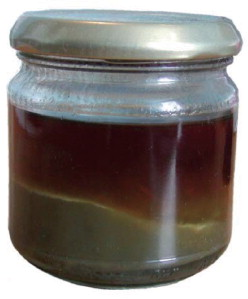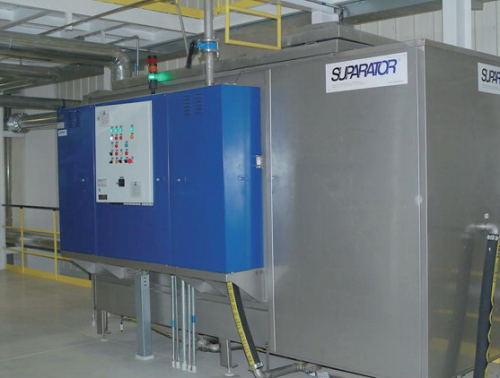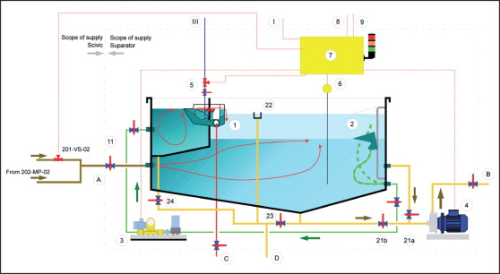



Oil/water separation is a common water treatment method. There are few industries where this type of separation is not used in some form and suppliers of oil/water separators are abundant. However, oil/water separation is not easy. If you take a jar and fill it with water, put some ‘straightforward’ oil on top and shake it, all you need to do to separate the oil and the water is to put the jar on a table and wait. Shortly there will be a layer of oil floating on the surface and all that is left to do is to remove the oil layer. However, oil/water separation is not as simple as that. Oil separates from water under gravity; in the jar, it is gravity that makes the oil float to the surface. Every oil separator relies on this mechanism, and so does a Suparator® oil separator. However, it takes time for the oil to separate. Depending on the difference in density between oil and water, the temperature, the size of the oil droplets in the mixture and the type of oil, the separation may take from minutes to days. This is the situation with pure water and pure oil. However, there are no industrial applications where pure oil needs to be separated from pure water. In industrial applications there are wastewaters, aqueous cleaners and machine coolants. These all contain all sorts of pollution and different types of oil, mechanically and chemically emulsified. In these applications, oil separation is a big challenge. The Suparator® oil/water separation technology is a technology that takes all these factors into account and has been developed and improved to get the best possible results.
The system
At the heart of every Suparator® solution is the Suparator® mechanism or device. It is a simple mechanism which uses flow dynamics to collect, concentrate and separate traces of oil, and remove it from the process, continuously and quickly. One of the factors that influence the velocity at which oil separates under gravity is the concentration of oil in the mixture. It can easily be demonstrated in the jar; the more oil you put in the jar, the faster the water phase becomes clear. By concentrating oil traces, the Suparator® device increases the velocity of the oil separation. Every oil separator will separate oil when the concentration in the mixture is high enough. If you need something that separates oil, most separators will be adequate. However, oil/water separation is not about the oil. It is about the water and how clean the water is following separation. To get a low oil concentration, it is necessary to separate out even the small traces of oil, at low oil concentrations. An ordinary oil/water separator will be not much more than a tank where the oil can float to the surface. As the layer on top increases, it reaches a weir or skimming pipe or funnel and oil starts to run off over the edge. That leaves a considerable layer of ‘oil’ on the surface at all times, accumulating dirt and allowing different types of oils and chemistry to mix. Add some bacteria growth and the result will be as seen in Figure 1. Long before that time, the oil/water separator stops functioning and all that can be done is to clean it completely and start over again. By continuously collecting, concentrating and removing even traces of oil the Suparator® device prevents this situation occurring. The consequence of this continuous concentration and removal of oil is that the oil is removed from the process quickly. First of all this prevents mixing of different ‘oils’, which result from changes in the production process or production batches. Secondly, the dirt, which is contained in the oil, is removed with it and only separates from the oil once in the drum. The dirt is also taken out of the process – see Figure 2.
Application
Just as important as the oil separator and how it performs, is how the oil separation is integrated with the process. To separate oil from a cleaning bath, a tank with coolant or a wastewater pit, requires several things. A device that separates oil from water is needed – the separator – as well as a way of bringing the oil to the separator. Every installation based on Suparator® technology, uses the Skim & Treat method. Specially designed Suparskim® skimmers are integrated with the process installation and take the surface layer from the medium. Specially selected pumps feed this medium into the Suparator® units where the actual separation takes place. Gravity separation takes place everywhere – in all the process installations, tanks and baths. Regardless of the conditions in the process, the highest concentration of oil will be found at the surface. By using the Suparskim® skimmers, the medium fed into the Suparator® unit already has a higher oil concentration. Special pumps are necessary to prevent mixing of oil and water and emulsification of the oil. Using the wrong type of pump to transfer the medium from the Suparskim® skimmer to the Suparator® unit could easily make the complete oil separation ineffective or even not functional at all. Finally it is necessary to integrate an oil/water separation system with an existing process installation, and frequently this is either ignored or neglected. Suparator® systems are used primarily for aqueous cleaning baths and coolant system in the metal and automotive industry. Suparator® is used on many automotive pre-treatment lines were car bodies are cleaned, prior to being coated.




